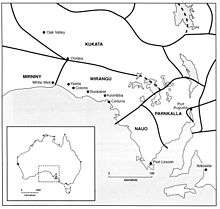Nauo people
The Nauo (Nawu) were an Aboriginal Australian people of South Australia who spoke the Nauo language. They became extinct by the end of the nineteenth century.
Country
The Nauo were a people of the Eyre peninsula. Their principal centres were around the scrub gum forest areas of the southwestern coast. According to Norman Tindale's estimate, their combined territory covered approximately 8,000 square miles (21,000 km2). Their western frontiers lay around Cape Radstock, northwards to beyond Minnipa. Their eastern extension ran close to Darke Peak, and took in the areas west of Cleve and halfway between Carrow and Franklin Harbor. Port Lincoln, Mount Hope, Coffin Bay, and Elliston were all part of Nauo territory.[1]
Mythology
According to Nauo beliefs, the spirits of the departed are thought to dwell on the islands in Spencer Gulf.[2] George French Angas wrote in 1847 the following legend:
They affirm that the Nauo tribe was once entirely cut off by a great and powerful warrior, styled Willoo (eaglehawk). This formidable individual attempted to possess himself of all the women, and destroyed every man except two, who escaped by climbing into thick trees. Their names were, Karkantya and Poona (two smaller species of hawk). Willoo climbed after them, but they broke off the branch upon which he sat, and he fell to the ground; that instant a dog deprived him of his virility, when he immediately died, and was transformed into an eagle-hawk. A small lizard is supposed to be the originator of the sexes. The men distinguish it by the name of ibirri, the women call it waka: the men destroy the male lizards, and the women the females.[3]
History of contact
It is thought that, before the advent of white colonisation, the Nauo had a more northern boundary extension from the Gawler Ranges to Port Augusta. They were pressed to move further south by the time white settlement began, as the Barngarla's relocation brought pressure to bear on them from the north.[1] At the same time, devastation came in from the south with the establishment of sealing stations along their southern coastal frontiers, whose men, together with escapees from Tasmanian prisons, kidnapped many Nauo women, beginning with raids in the first decades of the 1800s from their bases on Kangaroo Island.[lower-alpha 2][4] The violence of these early encounters may explain the hostility of the Nauo to later settlers.[5] The Waterloo Bay Massacre, near Elliston, which is said to have taken place around 1846, is still a contentious historical issue. Tindale summarised the rumour as follows:
Following the killing of a shepherd named Hamp, and the wife of another immediately afterward, it is claimed that 160 well-armed men drove a large group of aborigines, said to have numbered 260, over a cliff into the sea. According to this entirely unconfirmed report, only two aborigines survived.[6]
Whatever the truth, some Nauo were still in that area years afterwards.
As late as 2017, agreement between the successor Wirangu community and the Elliston municipal council on the terms to be used to describe what happened were still stalled, with representatives of the latter stating that "massacre" was too strong a word to describe what has been traditionally called the "Elliston incident", where "something happened" but the details are unknown.[7]
Alternative names
- Battara. (bat:ara meaning a variety of scrubby gum)
- Gnowoo
- Hilleri[8]
- Kadu. (the term meant 'man')
- Kartawongulta. (language name)[1]
- Ngao. (late (1939) Barngarla exonym)
- Njau, Njao,Nawo, Naua, Nowo
- Wiljaru. (Barngarla exonym meaning 'westerners')
- Willuro
Notes
- Tribal boundaries, after Tindale (1974), adapted from Hercus (1999).
- The lawless white men of presettlement days on Kangaroo Island (Tindale, 1937) raided them in the early 1800s. At least one Nauo woman survived on that island for many years. She was seen in company of a white sealer, along with Tasmanian women, at King George Sound and sketched in 1820 (Louis C. D. de Freycinet, 1829-1834). After colonisation in 1836, there was trouble and several settlers were killed in the Port Lincoln area. At the Green Patch homestead there are still preserved heavy hand-thrown solid barbed spears obtained after one such attack. (Tindale 1974, p. 136)
Citations
- Tindale 1974, p. 214.
- Angas 1847, p. 108.
- Angas 1847, p. 109.
- Tindale 1937, pp. 29–37.
- Tindale 1974, p. 66.
- Tindale 1974, p. 136.
- Gage 2017.
- Howitt 1904, p. 44.
Sources
- "Aboriginal South Australia". Government of South Australia.
- "AIATSIS map of Indigenous Australia". AIATSIS.
- Angas, George French (1847). Savage life and scenes in Australia and New Zealand (PDF). Volume 1. Smith, Elder and Co.CS1 maint: ref=harv (link)
- Gage, Nicola (21 July 2017). "Waterloo Bay 'massacre' debate rages as Aboriginal community looks for 'closure'" (PDF). ABC News.CS1 maint: ref=harv (link)
- Howitt, Alfred William (1904). The native tribes of south-east Australia (PDF). Macmillan.CS1 maint: ref=harv (link)
- Schürmann, Clamor Wilhelm (1879). "The Aboriginal Tribes of Port Lincoln" (PDF). In Woods, James Dominick (ed.). The Native Tribes of South Australia. Adelaide: E.S. Wigg & Son. pp. 207–252.CS1 maint: ref=harv (link)
- Tindale, Norman Barnett (1937). "Tasmanian aborigines on Kangaroo Island". Records of the South Australian Museum. 6 (1): 29–37.CS1 maint: ref=harv (link)
- Tindale, Norman Barnett (1974). "Nauo (SA)". Aboriginal Tribes of Australia: Their Terrain, Environmental Controls, Distribution, Limits, and Proper Names. Australian National University Press. ISBN 978-0-708-10741-6.CS1 maint: ref=harv (link)
- Wilhelmi, Charles (1860). "Manners and customs of the Australian natives, in particular of the Port Lincoln district". Transactions of the Royal Society of Victoria. 5: 164–203. ISBN 978-0-708-10741-6.CS1 maint: ref=harv (link)
